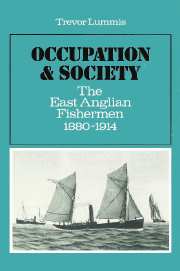Book contents
- Frontmatter
- Contents
- List of figures and tables
- Acknowledgements
- Map
- Introduction
- PART ONE OCCUPATIONAL STRUCTURE
- PART TWO THE SOCIAL STRUCTURE
- PART THREE THE FAMILY, SOCIAL PRACTICE AND BELIEF
- Introduction
- 9 Female waged labour
- 10 Domestic life
- 11 Leisure
- 12 Religion: practice and belief
- 13 Community and conclusion
- Appendix: supplementary information on the interviews
- Glossary
- Notes
- Bibliography and sources
- Index
9 - Female waged labour
Published online by Cambridge University Press: 22 October 2009
- Frontmatter
- Contents
- List of figures and tables
- Acknowledgements
- Map
- Introduction
- PART ONE OCCUPATIONAL STRUCTURE
- PART TWO THE SOCIAL STRUCTURE
- PART THREE THE FAMILY, SOCIAL PRACTICE AND BELIEF
- Introduction
- 9 Female waged labour
- 10 Domestic life
- 11 Leisure
- 12 Religion: practice and belief
- 13 Community and conclusion
- Appendix: supplementary information on the interviews
- Glossary
- Notes
- Bibliography and sources
- Index
Summary
The fishwife lends a hand, overhauls the nets, counts the fish into tubs and baskets, and keeps a keen eye on the payments. All the boats have come in now, and Yorkshire men and Cornishmen jostle each other round the fish buyers; bids are rapidly offered and taken, the wife puts in a last word, and the bargain is made.
Joseph R. Bagshawe 1933In many traditional communities women collected shellfish for bait, baited the lines and repaired net their involvement in the commercial dimension is revealed in the extract above describing Whitby around the turn of the century. Similar accounts can be found in many contemporary sources and one Cornish working fisherman who had a paper published on mackerel fishing in 1883 wrote of the share division between crew, nets and boat ‘We leave all that to the women.’ In other words the pattern of production was markedly pre-industrial with women and the family as a unit of production. But just as the East Anglian fishermen showed local peculiarities – working on Sundays, individual ownership and so on – so the work pattern of women did not conform to the traditional role of women in inshore fishing communities. Very few women had any direct connection with the fishing process through collecting or preparing bait and fishing lines nor even through preparing or hawking fish. Indeed, it was exceptional for them even to make or mend nets save as employees in the netchambers connected with the drifting industry.
- Type
- Chapter
- Information
- Occupation and SocietyThe East Anglian Fishermen 1880-1914, pp. 121 - 130Publisher: Cambridge University PressPrint publication year: 1985



